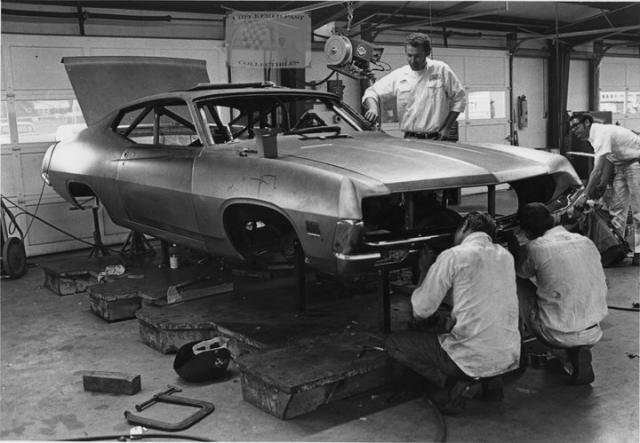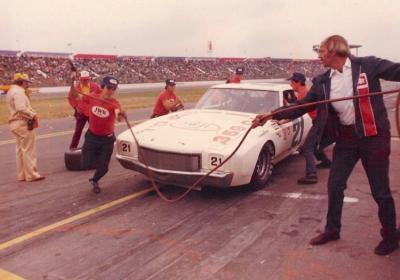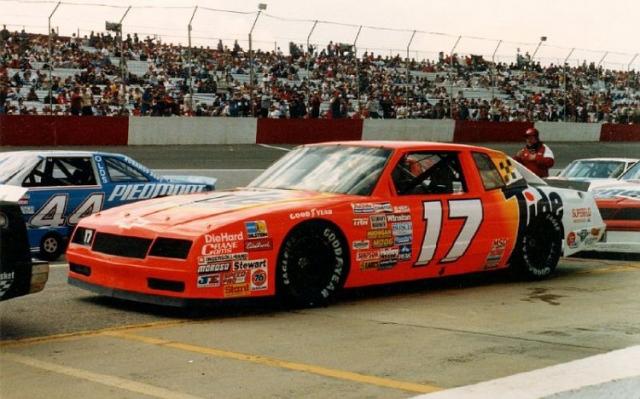We tend to agree that “There’s nothing stock about a stock car” as the machines circling around in NASCAR today are obviously related in name only to their showroom counterparts, but it hasn’t always been that way.
 We decided to take a deeper look at the history of NASCAR’s stock cars and piece it all together. It should be noted that this article is not intended as a slam towards NASCAR or any form of racing that uses a production make and model as the basis of their race cars; far from it. We’re actually NASCAR fans. Our intent is simply to understand the time line and evolution of the stock cars themselves, nothing more, nothing less.
We decided to take a deeper look at the history of NASCAR’s stock cars and piece it all together. It should be noted that this article is not intended as a slam towards NASCAR or any form of racing that uses a production make and model as the basis of their race cars; far from it. We’re actually NASCAR fans. Our intent is simply to understand the time line and evolution of the stock cars themselves, nothing more, nothing less.
Of course, we can trace NASCAR’s roots to the back roads snaking through the Carolinas and the dirt tracks sprinkled throughout the Southern United States. Made from dealer-available factory machines, the first stock cars were essentially production machines up into the 1950’s. Fueled by a growing public lust for more horsepower and bigger V8 powerplants, manufacturers soon found themselves scouting the hottest “shoes” and sharpest wheelmen for necessary input.
Engines like Oldsmobile’s Red Rocket and Chrysler’s Fire Power owe much of their existence to the achievements made in early stock car racing, as their power output put their company’s name in the winner’s circle weekend after weekend. While factories weren’t equipped to build dedicated race cars, manufacturers did find ways to supply cars to their top driving teams.
 The legendary ’57 Chevrolet “Black Widow” was a prime example. The creation of Chevrolet’s own team, it was birthed just as GM pulled from factory-supported racing. Still wanting to compete and needing a way around the GM mandate, a manual was created – called “The 1957 Stock Car Competition Guide” – and given to choice race teams that featured 170 different replacement parts that could be purchased directly from GM to create a really fast ’57.
The legendary ’57 Chevrolet “Black Widow” was a prime example. The creation of Chevrolet’s own team, it was birthed just as GM pulled from factory-supported racing. Still wanting to compete and needing a way around the GM mandate, a manual was created – called “The 1957 Stock Car Competition Guide” – and given to choice race teams that featured 170 different replacement parts that could be purchased directly from GM to create a really fast ’57.
Equipping the 150-class business coupe ’57 with 6-lug wheels and dual shocks at each corner, the “Black Widows” were all painted in a two-tone black-and-white paint scheme and equipped with a 283-horsepower fuel injected V8. For those following the cookbook instruction manual, things worked out well, with Chevrolet dominating NASCAR that year.
As competition grew more fierce, so did the technology. Mandated to carburetors (instead of fuel injection), manufacturers sought performance elsewhere. Ford’s monumental efforts into over-head-camshaft technology lead to a neck-and-neck race to the production line with Chrysler resulting in Ford’s legendary 427 SOHC and Chrysler’s 426 HEMI “Doomsday Machine” SOHC prototype.
 Realizing that OEMs were unrestrained by budgetary constraints, NASCAR director Bill France Jr. began implementing strong regulations that would restrict chassis, powertrains and body styles could compete in the circuit in help level the playing field to a level where other manufacturers might be able to compete.
Realizing that OEMs were unrestrained by budgetary constraints, NASCAR director Bill France Jr. began implementing strong regulations that would restrict chassis, powertrains and body styles could compete in the circuit in help level the playing field to a level where other manufacturers might be able to compete.
The 1960’s were unusual as manufacturers started making production cars for the sole purpose of complying with NASCAR’s strict homologation rules. Literally the reverse of the normal process of making a race car out of a production car, manufacturers were reaping the spoils of battle. Popularized by unprecedented media coverage, OEMs were motivated to adhere to NASCAR’s rule stating that at least 500 cars had to be produced, or as many as one car for every make’s dealership in the nation had to be sold to the general public to allow it to be raced.
Thus, specialty cars like the aptly named Ford Fairlane 500 and Dodge Charger 500 came on the scene. Advances to aerodynamics originally intended to eke out some extra miles per hour on the super speedways found themselves on production-built vehicles. Machines like the Ford Torino Talladega, Dodge Charger Daytona, and Plymouth Superbird were sales floor duds but asphalt heroes.
Yet, in totaling up the millions of dollars spent, it raises the questions as to why manufacturers were so inclined to do so? The phrase, “Win on Sunday, Sell on Monday” was as true as it could be, and buyers were more than eager to drive a street version of the machine that lead the pack out on the track.
To dig further into the mystery of the evolution of stock cars, we contacted Albert “Buz” McKim, a NASCAR Historian at the NASCAR Hall of Fame in Charlotte, NC. In our conversation we learned a number of insights, some of which were very surprising. Mr. McKim’s insights are as follows:
Street Legal TV: How long were stock style factory frames used in NASCAR?
Buz McKim: For the most part, stock bodies and frames were used in NASCAR until the 1967 Ford Fairlane, which was a unibody car. Beams were used to tie the front and rear subframes together which made it far safer and gave much more secure points to mount the roll cage. After that, things slowly evolved into rolling race chassis.
The stock front clip of the car was used into the early 1970’s but the remainder of the car was fabricated. Most race teams were doing their own rear frame clip which allowed them to put their springs in different locations to get them to work, and I don’t think NASCAR was real rigid on that sort of thing back then. It gave the builders a lot more flexibility. They could modify the A-Frame locations as well.
SLTV: Just from a visual point of view, it looks like the cars wore stock bodies well into the 1970’s. How long did stock cars utizile factory sheet metal?
Buz: Well, even up into the 1980’s they strongly resembled the factory version. If you look at the ’85 Thunderbird that Bill Elliot ran, or the ’86 Monte Carlo that guys like Earnhardt ran, the car still very much resembled the factory version. It was probably in the early ‘90’s that they really went away from looking like the factory car. At that point the only thing matching a stock factory body piece was the roof and the hood. Everything else was completely hand fabricated. In fact, until 2003, the hood, roof, and decklid were still required to be identical to their stock counterparts.
What really changed things body-wise was the ’83 T-Bird, because it was the beginning of the super aerodynamic cars we know of now. It’s a very round car with very few flat panels. Up until 1990 or so, teams would get “white” bodies from the manufacturers and use the quarter panels, roof, A-pillars, hood, and then fabricate everything else.
Interestingly enough, I have a quarter panel from one of the cars used in the 1990 movie, “Days of Thunder.” The gauge of the metal used in 1990 was far thicker than the cars that are run today, which are as thin as lunch meat wrappers! It’s just an example of technology moving forward.

Richard Petty working on a Torino for the 1970 year of NASCAR. It would never be used as Petty switched to back Plymouth before the end of 1969.
Up until when the “Car of Tomorrow” came in 2007, the cars were getting out of control. They were twisted, offset, and looked nothing like the factory version. One of the things NASCAR hoped to do with the “Car of Tomorrow” was to get it looking more like its factory counterpart. If you look at the Nationwide series at the new Challenger, it’s a car that quite closely resembles a stock Challenger body-wise. NASCAR hopes to continue that because one of their worries is that fan interest may have waned a bit due to the fact that the cars couldn’t be identified easily.
 SLTV: When did the factory engine size restriction leave NASCAR? We recall seeing Dodge Chargers with “426cui” printed on the hood, but today the showroom version of most stock cars is a small fuel injected V6.
SLTV: When did the factory engine size restriction leave NASCAR? We recall seeing Dodge Chargers with “426cui” printed on the hood, but today the showroom version of most stock cars is a small fuel injected V6.
Buz: That all really came about around 1973 or 1974. It was kind of in conjunction with the oil crisis and that Detroit was starting to downsize their engines. So NASCAR, like in 1981 when they downsized their car to a 110-inch wheelbase, they were just in line with what Detroit was doing. It was standardized at 358 cubic inches and had a carburetor, and that’s what it is today.
SLTV: You mentioned that the 110-inch wheelbase was mandated in 1981. What was it before then?
Buz: Prior to 1981, I believe it was 115-inches, which is what most cars were then anyway. There was actually a range used at one point to allow for the different sizes of cars to fit into it since the wheelbase could not be altered from the factory dimension.
SLTV: When did the factory-style suspensions leave NASCAR? They’re all running coil springs in front now with truck arms and coil springs in the back.
Buz: Well, I can’t say for sure, but in the 1960’s you still had to use factory suspension, torsion bars, leaf springs, etc., but could add as many leaves as they wanted, move the shackles, etc. When GM went to coil springs, it really threw people off as they had no experience with rear coil springs. It gave them a lot more to play with as far as tuning goes. The Mopar guys complained quite a bit about trying to get torsion bars to work on road courses!
SLTV: When did purpose-built race chassis enter NASCAR?
Buz: Well, that really all started with Banjo Matthews, somewhere around 1970. He purchased a chassis jig from Ralph Moody and went out and made a ton of money building cars with it. Almost every car that won in the 1970’s had one of his chassis. I once asked Ralph Moody about it and he joked with me saying, “I did sell a jig to Banjo, but I didn’t sell him my good one!”
Why were Banjo’s chassis so popular? What set them apart from everyone else? Cars built by Matthews had won 262 of 362 NASCAR Winston Cup races from 1974-1985, including all 30 races in 1978, and four consecutive Winston Cup championships (1975-78). Statistics like that are no accident!
 We found this over on LegendsOfNASCAR.com: “In 1963, [Matthews] left the driving to others, joining the Ford factory team building cars for Parnelli Jones, A. J. Foyt, Donnie Allison, Pete Hamilton and Bobby Isaac. When the factories pulled out, Banjo opened his own shop, and the legend began. He made a deal with John Holman of Holman-Moody, and built kit-type Fords in 1971.
We found this over on LegendsOfNASCAR.com: “In 1963, [Matthews] left the driving to others, joining the Ford factory team building cars for Parnelli Jones, A. J. Foyt, Donnie Allison, Pete Hamilton and Bobby Isaac. When the factories pulled out, Banjo opened his own shop, and the legend began. He made a deal with John Holman of Holman-Moody, and built kit-type Fords in 1971.
“Matthews built the body and framework, and H-M put in the motors. After that, he built cars for Chevrolet, and then later for others from his own shop. Cars built by Matthews won 262 of 362 NASCAR Winston Cup races from 1974-1985, including all 30 races in 1978, and four consecutive Winston Cup championships (1975-78). On many occasions, cars built by Banjo Matthews comprised over half the field.”
“The basic construction of a car is not what wins races,” Matthews said in a 1980 interview. “It’s the team effort after the car leaves our facility that separates the winners and losers. We strive to build our cars as good for one customer as we do for another. The credit for their performance goes to the people who operate them. I get my kicks, and so do my employees, from how well cars that we have built perform and the satisfaction they bring to the customers. That’s all the recognition I care about.”
Because of this, it’s easy to believe that the father of the modern stock car chassis – and maybe modern stock car racing itself – is none other than Banjo Matthews. After interviewing Buz McKim and learning more about Banjo Matthews, it would appear that innovators like Banjo, not NASCAR, are perhaps the reason NASCAR stock cars look like they do today.
It appears to have been a complete evolution of innovation within the confines of a racing series. People like Banjo, Smokey Yunick, and others who really could think outside the box and were set on building the fastest, safest, most innovative race cars they could within the confines of the rules, or more specifically, in the areas of the rules that were not clearly defined.
So, when it’s all said and done, the reason that “Stock Cars” no longer roll in NASCAR is a complex one, and certainly one that didn’t happen overnight. We love the racing we see on the track today, certainly, but the gearheads in us still pine for the day when stock cars wore real sheet metal and had a little more in common chassis-wise with their showroom counterpart. Sure, we now now that even those cars weren’t really “stock” anyway, but they sure looked cool.























